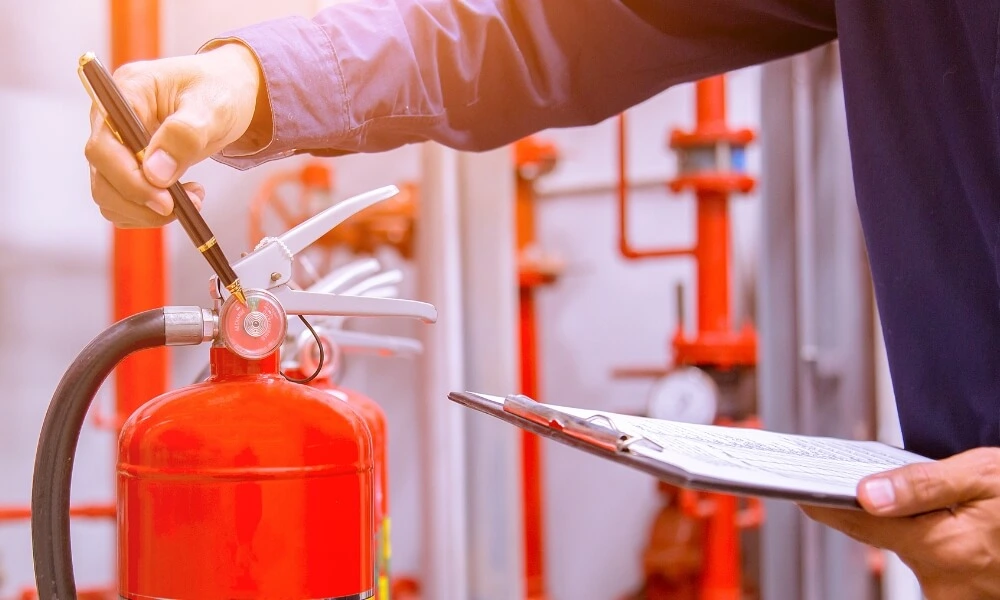Fire extinguishers are essential safety tools in our homes, offices, and public spaces. Their value, however, often goes unnoticed until an emergency arises – a situation where they need to perform flawlessly. Ensuring their readiness is not just about having them in place but also about routine maintenance.
In this blog post, we delve into why routine maintenance of fire extinguishers is an absolute must. From preventing corrosion to detecting leakage, mitigating wear and tear, and avoiding possible tampering or hose blockage – there’s more to fire extinguisher maintenance than meets the eye.
Our focus here is to highlight these reasons, emphasizing their vital role in maintaining safety standards and ensuring fire extinguishers work effectively when needed. So, join us as we explore each reason in-depth and enhance your understanding of this vital safety measure.
Why Must Fire Extinguishers Be Routinely Maintained?
Fire extinguishers are essential safety devices in any environment, as they can help control or extinguish small fires before they escalate into larger, more dangerous incidents. To ensure their effectiveness, it is crucial to routinely maintain fire extinguishers. Here are several reasons why routine maintenance is necessary:
1. To Prevent Damage from Corrosion
Fire extinguishers are typically made of durable metals such as steel or aluminum, selected due to their ability to resist pressure from compressed gas. However, as time goes by, these metals can degrade or rust, potentially affecting the strength of the cylinder. If this structural degradation becomes severe, it may lead to a malfunctioning or even complete failure of the fire extinguisher.
To counteract this, routine fire extinguisher maintenance includes an in-depth analysis of the device’s internal and external conditions. This way, any signs of corrosion or other physical damage can be identified and addressed early, ensuring your fire extinguisher remains in optimal working condition.

2. To Detect and Prevent Tampering
Fire extinguishers can pique the curiosity of individuals, particularly the younger generation. When placed in publicly accessible areas, these devices risk being tampered with. The extent of tampering can vary widely, from removing the safety pin or head-cap seal, loosening the hose, partially discharging its contents, or relocating the extinguisher from its designated spot.
At times, these interferences may not be malicious but accidental, such as using the extinguisher as a door stop or moving it for cleaning purposes. However, these instances can still lead to the extinguisher becoming unfit for use, which would violate the British Standard for safety devices.
Routine servicing of your fire extinguishers includes thorough checks for any signs of tampering. If you notice or suspect that an extinguisher has been tampered with, you must notify your service provider immediately to assess and address any issues. For chronic tampering issues, you might consider investing in tamper-proof extinguisher cases or protective covers to ensure your fire extinguishers remain functional and compliant.
3. To Prevent Hose Blockages
With time, the discharge hose of your fire extinguishers may accumulate debris or become a home for insects, resulting in blockages. These obstructions can impede the extinguisher’s functionality when you need it most. Moreover, the O-rings on the hose and connector can degrade over time, potentially affecting the performance of the extinguisher.
Regular maintenance services conducted by experienced technicians include a comprehensive check of the fire extinguisher’s discharge hose. They also ensure routine replacement of worn-out O-rings, ensuring the hose’s functionality. These preventative steps are crucial to keeping your fire extinguisher in working order and ready to perform when needed.
4. To Detect Leakage
Each fire extinguisher carries a clearly marked weight on its maintenance label, which serves a crucial purpose beyond indicating the lifting difficulty. This weight is a straightforward way to determine if the extinguisher’s contents remain intact.
As part of regular fire extinguisher inspections, trained engineers measure the weight of the extinguisher and compare it to the previous inspection’s recorded weight. If there is a decrease of more than 10% in the extinguisher’s weight, it often signals a possible leak. Upon detecting such a discrepancy, the engineer will then identify the leak’s source.
Furthermore, many fire extinguishers feature a pressure gauge within the valve assembly, also tested during regular maintenance checks. These routine weight and pressure assessments ensure the extinguisher’s readiness and effectiveness in an emergency.

5. To Mitigate the Impact of Normal Wear and Tear
Like any other physical equipment, fire extinguishers are subject to general wear and tear over their lifespan. This can manifest as minor scuffs on the paint or fading labels. While these changes might appear harmless or cosmetic, they can have significant implications. For instance, with time, the maintenance label on the extinguishers may fade, rendering crucial information illegible to the service technician.
Moreover, if the instruction label is damaged or faded, a user could mistakenly choose an inappropriate extinguisher for a specific type of fire or be unable to read the operating instructions. Therefore, during regular servicing, the engineer ensures that all labels on your fire extinguishing equipment are readable and clear, safeguarding its proper use during emergencies. Regular maintenance helps to mitigate the risks associated with normal wear and tear and ensures that your fire extinguishers remain reliable and effective.
Conclusion
In conclusion, fire extinguishers are important safety tools and life-saving devices that demand regular upkeep to function effectively during emergencies. The need for routine maintenance extends beyond compliance with safety regulations. It is essential to ensure that these devices can successfully combat fires when every second counts.
We’ve delved into five key reasons – mitigating corrosion, preventing tampering, addressing hose blockage, detecting leakage, and managing the impacts of general wear and tear – emphasizing the critical nature of these often overlooked aspects. Each fire extinguisher’s readiness and reliability are contingent upon regular, professional maintenance.
Your fire extinguishers’ condition is not something to gamble with. Take charge, prioritize routine maintenance, and ensure they remain in optimal working condition. This ensures safety and peace of mind, and compliance with fire safety regulations. Remember, a well-maintained fire extinguisher could be the difference between a minor incident and a major catastrophe.

